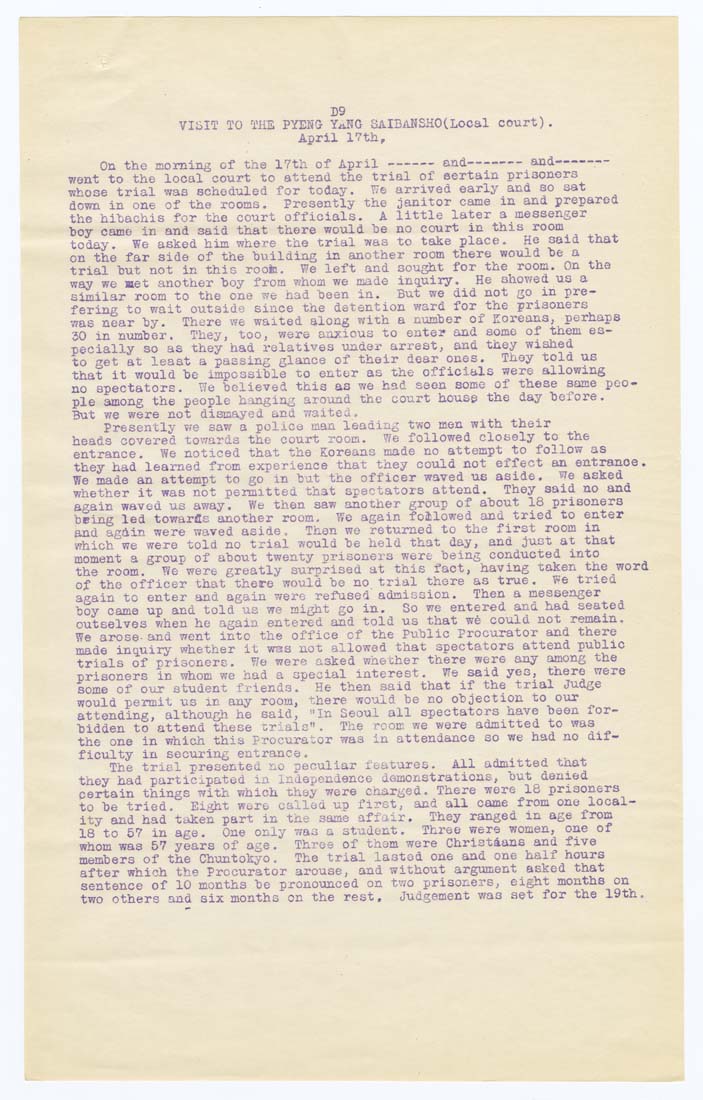D9
VISIT TO THE PYEHG YaHG SAlBiiKSHO(Local court) .
April 17th,
On the morning of the 17th of April------and-------and-----—
went to the local court to attend the trial of sertain prisoners
whose trial was scheduled for today. V7e arrived early and so sat
down in one of the rooms. Presently the janitor oame m and prepared
the hibaohis for the court officials. A little later a messenger
boy cane in and said that there would be no court m this room
today. We asked him where the trial was to take place. He said that
on the far side of the building in another room there would be a
trial but not in this roote. We left and sought for the room. On tha
way we met another boy from whom we made inquiry. He showed us a
similar room to the one we had been in. But we did not go in pre-
fering to wait outside since the detention ward for the prisoners
was near by. There we waited along with a number of Koreans, perhaps
30 in number. They, too, were anxious to enter and some of them es¬
pecially so as they had relatives under arrest, and they wished
to get at least a passing glance of their dear ones. They told us
that it would be impossible to enter as the officials were allowing
no spectators. He believed this as we had seen some of these same peo¬
ple among the people hanging around the court house the day before.
But we were not dismayed and vraited.
Presently vre saw a police man leading two mon with their
heads covered towards the court room. ?/e followed closely to the
entrance. We noticed that the Koreans made no attempt to follow as
they had learned from experience that they could not effect an entrance.
We made an attempt to go in but the officer waved us aside, We asked
whether it was not permitted that spectators attend. They said no and
again waved us away. We then saw another group of about 18 prisoners
being led towarfls another room. We again followed and tried to enter
and again were waved aside. Then we returned to the first room in
which we were told no trial would be held that day, and just at that
moment a group of about twenty prisoners were being conducted into
the room. Vie were greatly surprised at this fact, having taken the word
of the officer that there would be no trial there as true. We tried
again to enter and again were refused admission. Then a messenger
boy oame up and told us we might go in. So we entered and had seated
outeelves when he again entered and told us that we oould not remain.
?fe arose- and went into the office cf the Public Procurator and there
made inauiry whether it was not allowed that spectators attend public
trials of prisoners. We were asked whecher there were any among the
prisoners in whom we had a apeoial interest. We said yes, there were
some of our student friends. He then said that if the trial Judge
would permit us m any room, there would be no objection to our
attending, although he said, "In Seoul all spectators have been for¬
bidden to attend these trials". The room we were admitted to was
the one in which this Procurator was in attendance so we had no dif¬
ficulty in securing entrance. ^ .^^ .» *v, ..
The trie! presented no peculiar features. All admitted that
thoy had participated ia Independenoe demonstrations, but denied
certain things with which they v/ere charged. There were 18 prisoners
to be tried. Eight were called up first, and all came from one local¬
ity and had taken part in the same affair. They ranged m age from
18 to 57 in age. One only was a student. Three were women, one of
whom was 57 years of age. Throe of them were Christians and five
members of the Cbuntokyo. The trial lasted one and one half hours
after whioh the Procurator arouse, and without argument asked that
sentence of 10 months be pronounced on tv/o prisoners, eight months on
two others and six months on the rest. Judgement was set for the 19th.
|








